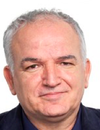Tuesday, 21 June 202208:00 | Conference Registration, Materials Pick-Up, Morning Coffee and Tea | |
Session Title: Lab-on-a-Chip and Microfluidics 2022 |
| | 08:50 |  | Conference Chair Welcome and Introduction to SelectBIO Rotterdam 2022 by Conference Chairperson
Claudia Gärtner, CEO, microfluidic ChipShop GmbH, Germany
|
| 09:00 |  | Keynote Presentation Microfluidics For Cancer Research
Valérie Taly, CNRS Research Director, Professor and Group leader Translational Research and Microfluidics, Université Paris Cité, France
Droplet-based microfluidics has led to the development of highly powerful tools with great potential in High-Throughput Screening where individual assays are compartmentalized within aqueous droplets acting as independent microreactors. Thanks to the combination of a decrease of assay volume and an increase of throughput, this technology goes beyond the capacities of conventional screening systems. Added to the flexibility and versatility of platform designs, such progresses in the manipulation of sub-nanoliter droplets has allowed to dramatically increase experimental level of control and precision. This technology has been key to recent developments in cancer research. These recent developments will be central to this presentation. In particular, we will show how by combining microfluidic systems and clinical advances in molecular diagnostic we have developed an original method to perform millions of single molecule PCR in parallel to detect and quantify a minority of target sequences in complex mixture of DNA with a sensitivity unreachable by conventional procedures. To demonstrate the pertinence of our procedures to overcome clinical oncology challenges, the results of clinical studies will be presented. |
| 09:30 |  | Keynote Presentation Cost Effective Nanobiosensors For Diagnostics: Towards Democratization of Evidence-based Health Care
Arben Merkoçi, ICREA Professor and Director of the Nanobioelectronics & Biosensors Group, Institut Català de Nanociencia i Nanotecnologia (ICN2), Barcelona Institute of Science and Technology (BIST), Spain
Nowadays health system is requesting more and more efficient diagnostics devices to afford everyday needs all over the world. The demand for point of care devices (POCs) for use at doctor offices or by people in need in any place in the world is increased due to various clinical scenarios including overall emergencies like pandemics. The development of such devices is strongly related to new materials and technologies being nanomaterials and nanotechnology of special role. We study how new nanomaterials such as nanoparticles or graphene can be integrated into simple sensing platforms thanks to their advantageous properties. Beside plastic platforms physical, chemical and mechanical properties of cellulose in both micro and nanofiber-based networks combined with their abundance in nature or easy to prepare and control procedures are making these materials of great interest while looking for cost-efficient and green alternatives for device production technologies. These devices should be REASSURED: Real-time connectivity, Ease of specimen collection, Affordable, Sensitive, Specific, User-friendly, Rapid, Robust, Equipment-free, Delivered to those who need it. How to design simple plastic/paper-based biosensor architectures including wearables through printing or stamping? How to tune their analytical performance upon demand? How one can couple nanomaterials with paper/plastics and what is the benefit? Which are the perspectives to link these simple platforms and detection technologies with mobile communication? I will try to give responses to these questions through various interesting applications related to protein, DNA and even bacteria and viruses with extreme interest for clinical emergency applications. The developed platforms and related technologies are related to ubiquitous methods that would be quite important for democratising diagnosis and improving the evidence-based healthcare coverage all over the world. |
| 10:00 |  | Keynote Presentation Ultra-Sensitive Optofluidic Platform for Point-of-Care Molecular Diagnostics
Holger Schmidt, Narinder Kapany Professor of Electrical Engineering, University of California-Santa Cruz, United States of America
Lab-on-chip systems can form the basis for next-generation molecular
biosensors for point-of-care use. In order to fulfill this potential,
they need to combine excellent specificity and sensitivity with speed,
robustness, and low cost. I will describe a waveguide-based optofluidic
platform that is ideal for this purpose. Specifically, I will review
ultrasensitive performance using the example of fluorescence and
label-free detection of SARS-CoV-2 from clinical nasal swab samples with
single molecule sensitivity. Multiplex detection of single viral
antigens is demonstrated along with dual detection of viral DNA and
antigen as well as label-free nanopore sensing of single RNAs with
2,000x enhanced detection rate. In addition, I will discuss approaches
geared at adapting this platform for point-of-case use, including novel
signal analysis algorithms and implementation of real-time analysis of
single-molecule fluorescence signals. |
| 10:30 | Mid-Morning Coffee Break and Networking in the Exhibit Hall | 11:00 |  Where Photonics Meet Microfluidics – Challenges and Opportunities For Consumables For Life Sciences and Diagnostics Applications in Glass Where Photonics Meet Microfluidics – Challenges and Opportunities For Consumables For Life Sciences and Diagnostics Applications in Glass
Tobias Bauert, Business Development Manager, IMT Microtechnologies
Fluid manipulation on the micro-scale allows new applications in various fields including life sciences and diagnostics. Many of these applications incorporate bio-sensors in a microfluidic setup. The choice of transduction mechanism for these bio-sensors creates the boundary conditions not only for the bio-chip itself but for the surface and bulk materials as well as the manufacturing technologies. Glass sometimes is the only choice due to limiting optical specifications or very harsh operating conditions. By harvesting the power of CMOS manufacturing technologies with non-CMOS compatible materials on glass, cost effective consumables for life sciences become reality in all volumes from prototyping to large scale manufacturing.
| 11:30 |  Emulseo: Formulation Solutions For Microfluidic Applications Emulseo: Formulation Solutions For Microfluidic Applications
Ariane Peyret, Technical Support and Marketing Manager, Emulseo
Water-in-oil emulsion droplets produced with microfluidic devices have become widely used as powerful tools for biological and chemical applications including screening, material synthesis, single-cell analysis, digital polymerase chain reaction assays (dPCR) or in vitro diagnostics. Droplet microfluidics enable chemical and biological experiments to be performed at high-throughput in a confined and controlled environment with enhanced efficiency and using minimal amount of starting material. These applications all require reliable formulation tools that meet essential quality criteria. Especially, surfactants are key to generating stable emulsions. Being able to fully control their synthesis in a reproducible way and at large scales is crucial. For these reasons, Emulseo has worked on developing custom-made solutions and ready-to-use formulations such as fluorinated surfactants, fluorinated oils, surface treatments and other specialty chemicals.
| 12:00 |  Moving Diagnosis Closer to the Patient: Smart Consumables For Novel Point-of-Care Solutions Moving Diagnosis Closer to the Patient: Smart Consumables For Novel Point-of-Care Solutions
Iris Prinz, Head of Sales and Business Development, STRATEC Consumables GmbH
Within the presentation we will focus on a Point-of-Care solution
realized at STRATEC Consumables jointly with Femtonics. This
Point-of-Care cartridge includes several challenges e.g. manufacturing
of fluidics including opening mechanism for blisters by injection
molding, content loading like dispensing and lyophilization as well as
several assembly steps in order to realize a diagnostic platform with
the aim to detect respiratory diseases.
| 12:30 |  | Keynote Presentation High-Throughput Microfluidic Cytometry
Andrew J deMello, Professor of Biochemical Engineering & Institute Chair, ETH Zürich, Switzerland
Flow cytometry is a ubiquitous analytical technique for enumerating and sorting cellular populations. Because of its quantitative and multi-parametric nature and the fact that cells may be probed at high throughputs, flow cytometry is considered to be the gold standard method for measuring the physical and chemical properties of a large cellular populations. Although modern-day flow cytometers are adept at processing thousands of cells per second, almost all require unacceptably large sample/reagent volumes and do not allow the acquisition of spatially resolved information. To address these issues, imaging flow cytometry (IFC) marries the advantages of optical microscopy and flow cytometry to allow the for high-throughput imaging of cells within flowing environments. I will describe how we have leveraged the capabilities of microfluidic systems to form novel IFC platforms able to manipulate, process and assay cells in a controlled and high-throughput manner. Examples will include chip-based imaging flow cytometers that leverage either inertial or viscoelastic focusing. Such systems operate at throughputs exceeding 400,000 cells/s, extract fluorescence, brightfield, and darkfield images and are capable of multi-parametric quantification and sub-cellular localization of structures down to 500 nm. Finally, I will describe recent activities focused on the development of a viscoelastic-based microfluidic platform able to measure the mechanical properties of cells at rates of up to 100,000 cells per second. Here, fluid elasticity is used to focus and deform cells in an integrated manner and without the need for a sheath fluid. |
| 13:00 | Networking Lunch in the Exhibit Hall with Exhibitors and Conference Sponsors + Poster Viewing | |
Session Title: Convergence of Microfluidics and POC Diagnostics Fields |
| | 14:30 |  Microfluidics Applications in the Life Sciences Sector Microfluidics Applications in the Life Sciences Sector
Mark Olde Riekerink, Senior Business Development Manager, Micronit Microtechnologies BV
Microfluidics is the science of manipulating small volumes of liquids. This field is rapidly evolving and can have an enormous impact on the progress in science and healthcare. This usually is executed on microchips made with manufacturing techniques also used in the semiconductor industry, like lithography, etching and thin film deposition. The chips contain small channels, which enable accurate control of liquids and chemical reactions. The use of small volumes allows quicker temperature shifts and faster liquid displacement. Moreover, microfluidics enables the automation and integration of complex operations on-chip, with reduced sample and expensive reagent volumes. With such properties, microfluidics can fit applications in the healthcare sector along with other microtechnologies. The approach starts from a conceptual design to prototyping to a final design and process transfer for volume manufacturing. A flexible approach allows the choice of a variety of materials and hybrid material combinations and customized designs e.g. for successful integration of multiple functions. This approach is of particular interest for developing relative complex designs with multiple micro- and nanostructures and functionalities on board. The collaboration of life sciences and microfluidics companies can help in developing technologies that can also reduce development costs, speed up time-to-market and increase success rates for cost-effective commercialization. During this talk, examples of industrial solutions and recent technology developments will be presented, with special focus on the life sciences sector.
| 15:00 |   | Keynote Presentation Optofluidic Devices For Disease Diagnosis
Lorena Diéguez, Leader of the Medical Devices Research Group, INL- International Iberian Nanotechnology Laboratory
Sara Abalde-Cela, Staff Researcher, International Iberian Nanotechnology Laboratory, Portugal
The capacity of microfluidic platforms as tiny labs transitioned from a potential to a reality as demonstrated in the past 20 years. The microfluidics community developed extremely advanced systems able to perform almost any chemical and/or biological lab protocol. However, in order to develop integrated lab-on-a-chip diagnostic platforms, it is crucial to couple microfluidic devices with detection strategies able to match the inherent properties of microfluidics: high-throughput, automation and miniaturization. One of those detection techniques is surface-enhanced Raman scattering (SERS) spectroscopy, an ultrasensitive and highly selective analytical technique with multiplexing ability. SERS is based on the use of plasmonic nanoparticles that act as nanoantennas and augment the very specific Raman signatures of molecules close to the nanostructured surfaces. We will show how the integration of different SERS sensing substrates and strategies within microfluidics and microdroplets offers a great flexibility for the diagnosis of several biological species and/or events. We will show examples in the context of liquid biopsy demonstrating the single-cell multiplex phenotypic analysis in a microdroplet, the detection of panels of mutations in cancer or the differentiation of cancer versus healthy cells. These approaches may be transferred to different analytical fields, such as the detection and discrimination of foodborne pathogens, bacteria or viruses in food or water samples. |
| 15:30 |  Microfluidics for Low-Throughput Assay Automation Microfluidics for Low-Throughput Assay Automation
Richard Chasen Spero, CEO, Redbud Labs
Lab automation reduces errors, improves consistency, and reduces costs. But while lab automation equipment is typically optimized for processing hundreds or thousands of samples per day, most labs work with much lower throughput—say, 10–100 samples per day, and therefore their workflows are almost always performed by hand. Redbud Labs has developed an automation platform optimized for low- to medium-throughput. We use a novel microfluidic agitation method to maximize reaction yield for sample prep and other assays, resulting in lab-quality yield, fast runtimes, and a compact design. We will report on performance of this system in a range of assays, from nucleic acid extraction to protein enrichment for immunoassays. We will also share strategies employed to develop our platform on a highly compressed timeline.
| 16:00 | Mid-Afternoon Coffee and Tea Break and Networking in the Exhibit Hall | 16:30 |  Upscaling of Microfluidic Biosensors Manufacturing by Imprinting, Printing and Lamination Processes on Polymer Foils Upscaling of Microfluidic Biosensors Manufacturing by Imprinting, Printing and Lamination Processes on Polymer Foils
Anja Haase, Senior Scientist, JOANNEUM RESEARCH Forschungsgesellschaft mbH
High throughput fabrication based on roll-to-roll UV imprint lithography of lab-on foil chips for protein or DNA detection is presented. Subsequent fabrication process steps, such as biomolecule spotting and chip lamination are also roll-to-roll based.
| 16:45 |  Novel Origami Foil Based Microfluidic Foils for DNA Amplification and Multiplex Detection Fabricated by R2R UV NIL Novel Origami Foil Based Microfluidic Foils for DNA Amplification and Multiplex Detection Fabricated by R2R UV NIL
Anne Linhardt, Scientist, JOANNEUM RESEARCH Forschungsgesellschaft mbH
We present the implementation of DNA amplification by LAMP as well as multiplex DNA detection using the same polymer foil based microfluidic chip. This is accomplished through our unique pilot line for high throughput production of microfluidic systems based on Roll-to-Roll (R2R) processes.
| 17:00 |  Microfluidic Chip For In Vitro Neuronal Cell Culture Under Electrical Stimulation Microfluidic Chip For In Vitro Neuronal Cell Culture Under Electrical Stimulation
Ana Ayerdi , Senior Researcher, Tecnalia Research & Innovation
A chip with a fluidic design that allows neuronal cell culture and axon growth monitoring was developed. This design consists of two separated chambers in which cells are seeded and allows the monitoring of axons outgrowth through the microchannels. Using industrial compatible processes, we have fabricated polymer shims and working stamps to manufacture such patterned surfaces both in a small scale plate to plate fashion as well as continuous high throughput roll-to-roll fabrication. The material choice allows for fluorescence microscopy imaging. The design was screened in vitro with different neuronal like cell lines and using several substrates that can be used for high throughput roll-to-roll manufacturing. The design is also compatible with a custom-made electrical stimulus generator. Neuronal cells respond to electrical stimulation in two ways: by increasing their cell size and by increasing the cell number in culture. With this approach chips that can be manufactured in a faster and roll to roll fabrication method for in vitro drug screening assays will be shown.
| 17:15 |  Colorimetric LOC Compatible with R2R Fabrication For Monitoring the Activity of Enzyme Extracts Colorimetric LOC Compatible with R2R Fabrication For Monitoring the Activity of Enzyme Extracts
Veronica Mora Sanz , Researcher, Tecnalia Research and Innovation
Using a colorimetric Lab-on-a-Chip (LOC) device, the activity of different organic enzyme formulations produced by an efficient fermentation technology are measured. Similar enzyme sensing strategies were chosen to take advantage of synergies in chip design. The methodology consists in a one-step reaction that uses specific substrates to produce a colored end-product. The microfluidic chip design compatible with roll-to-roll (R2R) extrusion coating fabrication consists on an inlet for the enzyme sample, a reaction chamber, and a capillary pump. The enzyme substrates were immobilized on the reaction chamber for simplify the handle for final user. Spotting was employed for the integration of the reagents on the chip because it is a compatible technique with R2R process. COC was chosen for the chip fabrication for its flexibility required in R2R manufacturing and its transparency necessary for colorimetric detection. An adhesive foil is used to cover the structured microfluidic foil. A portable readout device with UV-LED and photodiodes was developed for measuring the enzymatic activity in situ in the manufacturing plant.
| 17:30 |  Precise Contactless Spotting for Lab-on-Chip Applications Precise Contactless Spotting for Lab-on-Chip Applications
Florian Filbrandt, Application Sales, microdrop Technologies GmbH
| 18:00 |  Networking Reception with Beer and Wine: Network with Colleagues and Engage with Exhibitors and Conference Sponsors. French Wine Tasting Sponsored by Kloé Networking Reception with Beer and Wine: Network with Colleagues and Engage with Exhibitors and Conference Sponsors. French Wine Tasting Sponsored by Kloé
Paul Coudray, CEO, Kloé SAS
| 19:00 | Close of Programming on Day 1 of the Conference |
Wednesday, 22 June 2022 |
Please Refer to the POC Diagnostics Agenda for Details of Programming on Wednesday, 22 June 2022 |
| | |
Please Also Refer to the Organ-on-a-Chip Track Parallel Agenda for Details of Programming on Wednesday, 22 June 2022 |
| |
|
